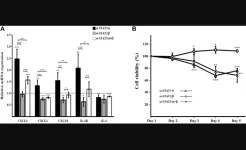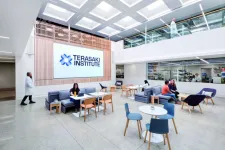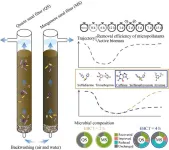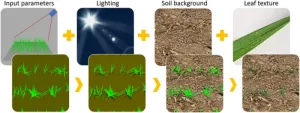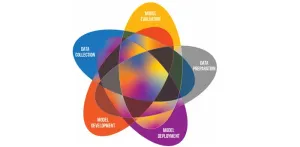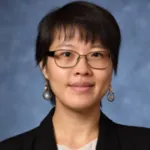Using microbes to get more out of mining waste
2023-04-27
(Press-News.org)
Researchers have developed a new mining technique which uses microbes to recover metals and store carbon in the waste produced by mining. Adopting this technique of reusing mining waste, called tailings, could transform the mining industry and create a greener and more sustainable future.
Tailings are a by-product of mining. They are the fine-grained waste materials left after extracting the target ore mineral, which are then stacked and stored. This method is called dry-stack tailing.
Over time, mining practices have evolved and become more efficient. But the climate crisis and rising demand for critical minerals require the development of new ore removal and processing technologies.
Old tailings contain higher amounts of critical minerals that can be extracted with the help of microbes through a process called bioleaching. The microbes help break down the ore, releasing any valuable metals that weren’t fully recovered in an eco-friendly way that is much faster than natural biogeochemical weathering processes.
“We can take tailings that were produced in the past and recover more resources from those waste materials and, in doing so, also reduce the risk of residual metals entering into local waterways or groundwater,” said Dr. Jenine McCutcheon, an assistant professor in the Department of Earth and Environmental Sciences.
In addition to improving resource recovery, the microbes capture carbon dioxide from the air and store it within the mine tailings as new minerals. This process aids in offsetting some of the emissions released while the mine was active and helps stabilize the tailings.
Microbial mineral carbonation could offset more than 30 per cent of a mine sites annual greenhouse gas emissions if applied to an entire mine. In addition, this microbial-driven technique gives value to historical mine tailings that are otherwise considered industrial waste.
“This technique makes better use of current and past mine sites,” McCutcheon said. “Rethinking how future mine sites are designed in order to integrate this process could result in mines that are carbon neutral from the get-go rather than thinking about carbon storage as an add-on at the end.
“This technology is a potential game-changer in the fight against climate change, and the mining industry has a unique opportunity to play a significant role in the future of green energy.”
McCutcheon further believes that the microbial-driven processes could help the industry move towards carbon-neutral or carbon-negative mining, but industry engagement is critical to move this technology towards large-scale deployment.
Dr. McCutcheon published this research with co-author and associate professor Ian Power of Trent University in the peer-reviewed journal PLOS Biology.
END
ELSE PRESS RELEASES FROM THIS DATE:
2023-04-26
About one-third of our lives are spent at work, and the relationships we build there can have personal and professional benefits. But a majority of workers indicate difficulty connecting with co-workers socially, especially in the new landscape of remote and hybrid work arrangements.
To ease the friction caused by reduced in-person interaction, a team of researchers from Carnegie Mellon University's Human-Computer Interaction Institute created a Slack application that helps to initiate casual conversations and create affinity groups in an online workspace.
"We were freshly out of the pandemic, and we realized that everyone around us was complaining ...
2023-04-26
“Our study emphasizes the importance of distinguishing between STAT3α and STAT3β proteins and their active forms when discussing STAT3-related cancer diagnosis and therapy.”
BUFFALO, NY- April 26, 2023 – A new research paper was published in Oncotarget's Volume 14 on April 24, 2023, entitled, “Differential silencing of STAT3 isoforms leads to changes in STAT3 activation.”
Signal transducer and activator of transcription 3 (STAT3) is a transcription factor involved in ...
2023-04-26
WOODLAND HILLS, Calif. – April 26, 2023 – The Terasaki Institute for Biomedical Innovation, a nonprofit dedicated to rapidly translating scientific knowledge into real-world solutions, will celebrate the grand opening of its latest biomedical research center with a ribbon-cutting ceremony on Saturday, April 29.
When: Saturday, April 29 at 11:30 a.m.
Where: 21100[ML1] Erwin St., Woodland Hills, Calif., 91367
What: ...
2023-04-26
Sand filters are commonly applied in drinking water treatment and can efficiently remove suspended solids, organic matter, and microorganisms from source water. During the process, particulate matter and microbes can attach to filter sands and develop a thick biofilm in both rapid and slow sand filters. To prevent clogging and restore pollutant removal efficiency, backwashing using air, water, or a combination of both is usually required for sand filters. However, backwashing can induce a loss in biomass, thus decreasing the pollutant ...
2023-04-26
A versatile new foam material developed by researchers at the University of Georgia could significantly reduce health care-related infections caused by implanted medical devices—or drastically improve cleanup efforts following environmental disasters like oil spills.
Like a spongy Swiss Army knife, the porous three-dimensional foam is water repellent—meaning it resists blood, microbes and proteins, while also exhibiting antimicrobial and oil-water separation properties. Its versatility, functionality and relatively inexpensive production costs could make it a valuable resource for future clinicians and environmental remediation professionals ...
2023-04-26
The University of Cincinnati's Soma Sengupta, MD, PhD, published an article in the Journal of Neuro-Oncology April 25 discussing her journey and approach to practicing integrative neuro-oncology.
Sengupta, associate professor in neurology, director of neuro-oncology clinical trials, associate director of the Brain Tumor Center and a UC Health neuro-oncologist, funded by the Harold C. Schott Endowed Chair in Molecular Therapeutics (Neurosurgery) and the Pam and Tom Mischell Funds, said she personally ...
2023-04-26
In cereal crops, the number of new leaves each plant produces is used to study the periodic events that constitute the biological life cycle of the crop. The conventional method of determining leaf numbers involves manual counting, which is slow, labor-intensive, and usually associated with large uncertainties because of the small sample sizes involved. It is thus difficult to get accurate estimates of some traits by manually counting leaves.
Conventional methods have, however, been improved upon with technology. Deep learning has enabled the use of object detection and segmentation algorithms to estimate the number of plants (and ...
2023-04-26
As temperatures across the globe reach record-level highs, urban areas are facing increased heat stress. Cities are generally warmer and dryer than adjacent rural land. But in the Global South, there is an additional complicating factor — urban humid heat.
A new study, led by Yale School of the Environment scientists and published in Nature, investigated the combined effect of temperature and humidity on urban heat stress using observational data and an urban climate model calculation. Researchers found that the heat stress burden is dependent on local climate and a humidifying effect can erase the cooling benefits that would come from trees and vegetation.
“A widely ...
2023-04-26
Artificial intelligence and machine learning (AI/ML) technologies are constantly finding new applications across several disciplines. Medicine is no exception, with AI/ML being used for the diagnosis, prognosis, risk assessment, and treatment response assessment of various diseases. In particular, AI/ML models are finding increasing applications in the analysis of medical images. This includes X-ray, computed tomography, and magnetic resonance images. A key requirement for the successful implementation of AI/ML models in ...
2023-04-26
As additive manufacturing becomes more commonplace, researchers are exploring new methods to ensure that products are as strong and more sustainable than their traditionally manufactured analogues. At the University of Pittsburgh, engineers have set their sights on using multiple lights and neural networks to improve the finishing process of this complex process.
Xiayun Zhao, assistant professor of mechanical engineering and materials science at Pitt’s Swanson School of Engineering, received a Faculty Early Career Development (CAREER) award from the National Science Foundation (NSF) for her research in photopolymer additive manufacturing (PAM). ...
LAST 30 PRESS RELEASES:
[Press-News.org] Using microbes to get more out of mining waste

